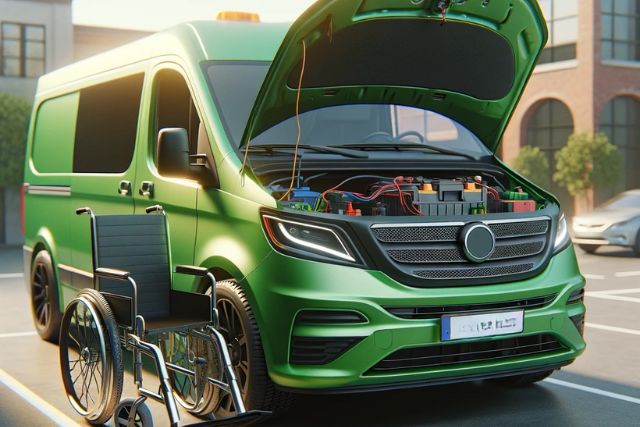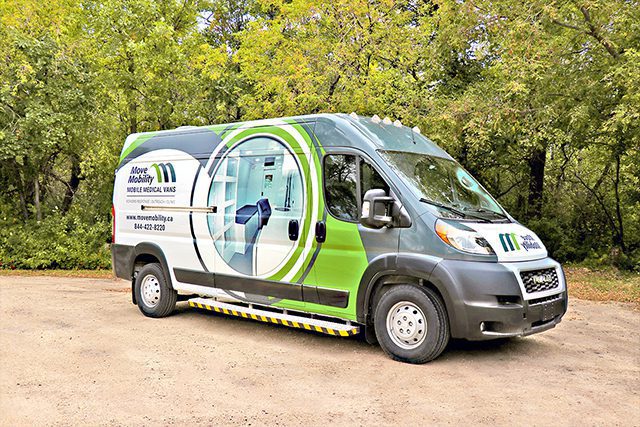You’re a wheelchair van driver who’s getting ready to pick up your first client on a bitterly cold Monday morning. You push the button on your command start and wait 5 minutes for the vehicle to warm up. Upon getting outside, you start walking to the van and realize it hasn’t even started yet. You open the door to the van and notice the battery is completely dead. Battery drainage problems are extremely frustrating.
Combined with the wind chill, some areas of Manitoba experience between –40 and -50 C temperatures. As you’re probably aware, prolonged temperatures like this can wreak havoc on a vehicle’s battery.
At MoveMobility, we manufacture wheelchair accessible vehicles so organizations like yours can help people overcome barriers to transportation. We’ve been in this business for over a decade, and after manufacturing hundreds of these vehicles, we know that no vehicle is completely immune to battery drainage problems at one point or another.
In this article, you’re going to learn more about the top 6 battery drainage problems for wheelchair vans. We’ll also provide you with some solutions that will help you deal with these problems.
What is battery drainage?
Battery drainage happens when the power stored in the van’s battery decreases, causing it to lose charge unexpectedly. Imagine your van’s battery as a juice box – when it gets used up, it needs a refill. Similarly, a wheelchair van relies on a charged battery to operate smoothly.
When you run into battery drainage problems for wheelchair vans, it’s more than just a minor inconvenience. Let’s take a brief look at a few examples of what can happen due to battery drainage.
Missed medical appointments: Without reliable wheelchair accessible transportation, your clients will struggle to make it to medical appointments, and this can impact their health management.
Stranded in emergencies: Imagine a scenario where the van unexpectedly breaks down due to a drained battery during an emergency. This situation can be stressful and potentially life-threatening.
Limited independence: Wheelchair users depend on their vans for independence. Battery drainage can restrict their ability to go to work, visit friends, or engage in community activities.
Unplanned expenses: Dealing with frequent battery issues can lead to unplanned expenses for repairs and replacements, affecting the financial well-being of users.
Emotional stress: Constant worries about the van’s reliability can cause emotional stress for wheelchair users and their families. This can have a negative impact on overall well-being.
Top 6 causes of battery drainage problems (with solutions) for wheelchair vans
Wheelchair vans are important for accessible transportation, but as you’re now aware, sometimes they face battery drainage challenges. Let’s explore the top five problems, starting with a common problem many of you have probably experienced if you live in cold climates.
1. Cold weather impact
Cold weather can be tough on wheelchair van batteries. Batteries struggle in the cold because lower temperatures slow down their internal chemical reactions. This sluggishness limits the battery’s ability to produce and deliver power efficiently.
Cold weather also increases the battery’s internal resistance. This makes it harder to supply the needed power to start the vehicle. Additionally, the engine’s oil thickens in the cold. Thicker oil in vehicles puts extra strain on the battery. Reduced overall capacity in chilly conditions leads to quicker drainage. Activities like using lights and heating the vehicle add more load, depleting the battery faster.
Solution
Invest in a battery blanket: Wrapping your van’s battery helps keep it warm during cold weather. This solution helps to prevent excessive drainage.
Trickle charger usage: Consider using a trickle charger during colder months. It provides a slow, steady charge that helps to maintain the battery’s health.
Now, let’s delve into the next problem.
2. Aging battery effect
As time passes, the battery in your wheelchair van ages. An older battery may not hold a charge as well as a new one. This makes it more susceptible to drainage.
Solution
Routine battery checks: Regularly inspect your battery’s health. If it’s getting older, consider replacing it proactively to avoid unexpected breakdowns.
Upgrade to a maintenance-free battery: Modern maintenance-free batteries often have a longer lifespan, providing a more reliable power source.
3. Electrical system challenges
Sometimes issues in the electrical system can contribute to battery drainage. A glitchy connection or a misbehaving component might be at play.
Solution
Professional diagnostics: If you suspect electrical problems, seek professional help for diagnosis and repair. Unless you’re a mechanic or skilled DIYer, electrical problems resulting in battery draining might be an issue you won’t be able to resolve on your own.
Regular inspections: Periodically inspect the wiring and connections in your van. Tighten loose connections and address any wire issues that you notice right away.
4. Parasitic drains
Parasitic drains occur when certain electrical components in the van continue to draw power even when it’s turned off. Over time, parasitic drains silently weaken the battery. Common culprits include electronic devices, clock displays, or malfunctioning systems that don’t fully power down when the vehicle isn’t in use.
Solution
Check for aftermarket accessories: Ensure added accessories don’t draw power when the van is off. That means you should turn off all accessories when you’re ready to exit the van.
Utilize battery disconnect switches: Installing a disconnect switch allows you to cut off power entirely when the van is not in use, preventing parasitic drains.
Consider a trickle charger: Using a trickle charger periodically can help maintain a consistent charge and counteract parasitic drains.
5. Irregular van use
When you don’t use your wheelchair van regularly, the battery may not get enough charging time.
Here’s why: Normally, when you drive, the alternator charges the battery and keeps it ready for action. But if your van sits idle for weeks or months, the alternator doesn’t get a chance to do its job.
Without regular use, the battery becomes undercharged. It’s like having a phone that you don’t plug in – over time, it loses power. In this case, an undercharged battery can lead to drainage and cause issues when you finally need your van to provide your clients with transportation.
Solution
Regular driving schedule: Plan regular longer drives to give the battery a chance to charge fully.
Try a trickle charger: This is another situation where a trickle charger can also be useful. When you foresee longer periods of inactivity, hook up the trickle charge to keep the battery charged and ready to go.
6. Ignored warning signs
It’s easy to overlook early battery drainage warning signs in your van. The downside to that is that they can turn into bigger problems further down the road. If you see warning lights on the dashboard, don’t ignore them.
Solution
Dashboard warnings: Pay attention to any dashboard warning lights or sounds. If you don’t know what they mean, contact the manufacturer for assistance on that.
Professional diagnostics: Schedule routine check-ups with the manufacturer or dealership you purchased your vehicle from to detect and address emerging battery concerns before they escalate.
Addressing these battery drainage problems ensures that your wheelchair van remains a reliable and efficient mode of transportation for your clients. Be proactive with these solutions to prevent unexpected issues and ensure that your van is always ready to roll.
Your next steps with MoveMobility

You found this article while looking for solutions to battery drainage problems for wheelchair vans.
Now that you know how important it is to keep your battery maintained, we have a few other articles that you should look at.
When you’re running an organization based on wheelchair accessibility, you don’t want battery drainage problems to slow you down. If you’re dealing with battery drainable problems or have any other questions related to wheelchair vans, don’t hesitate to click the button below to reach out to an expert.







